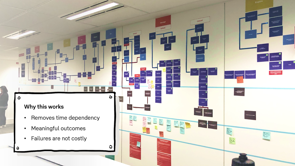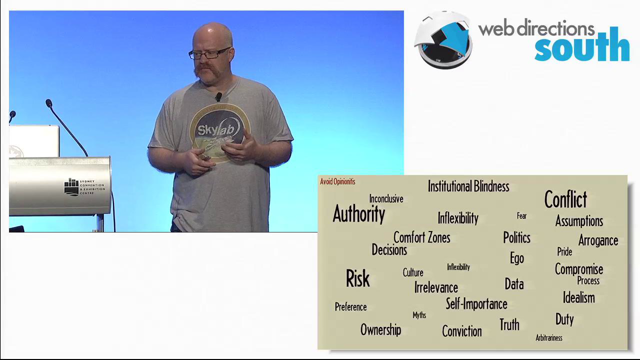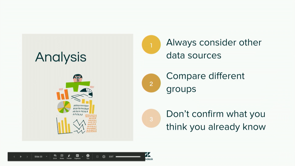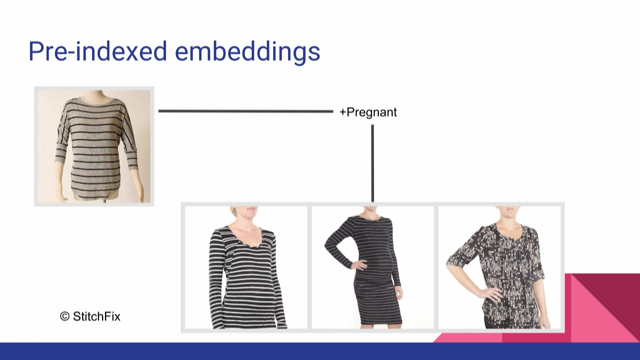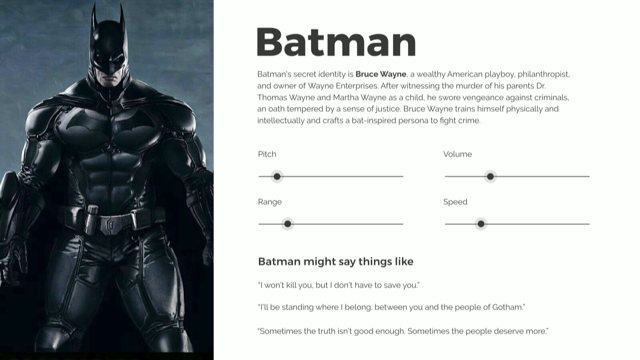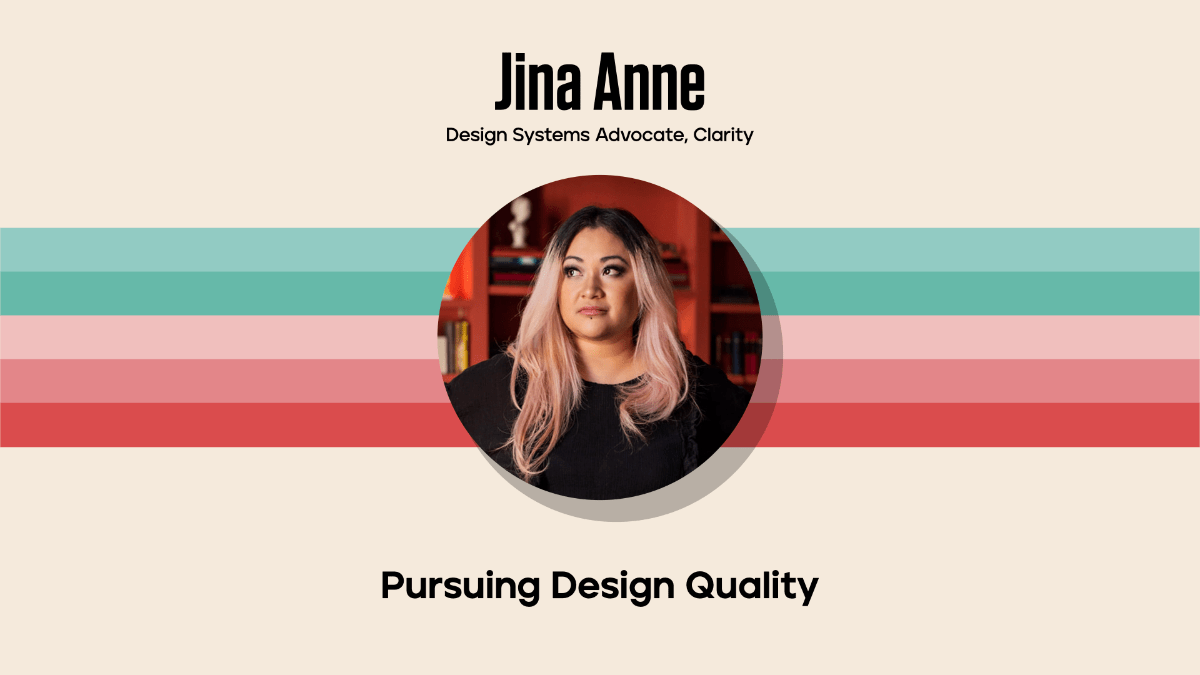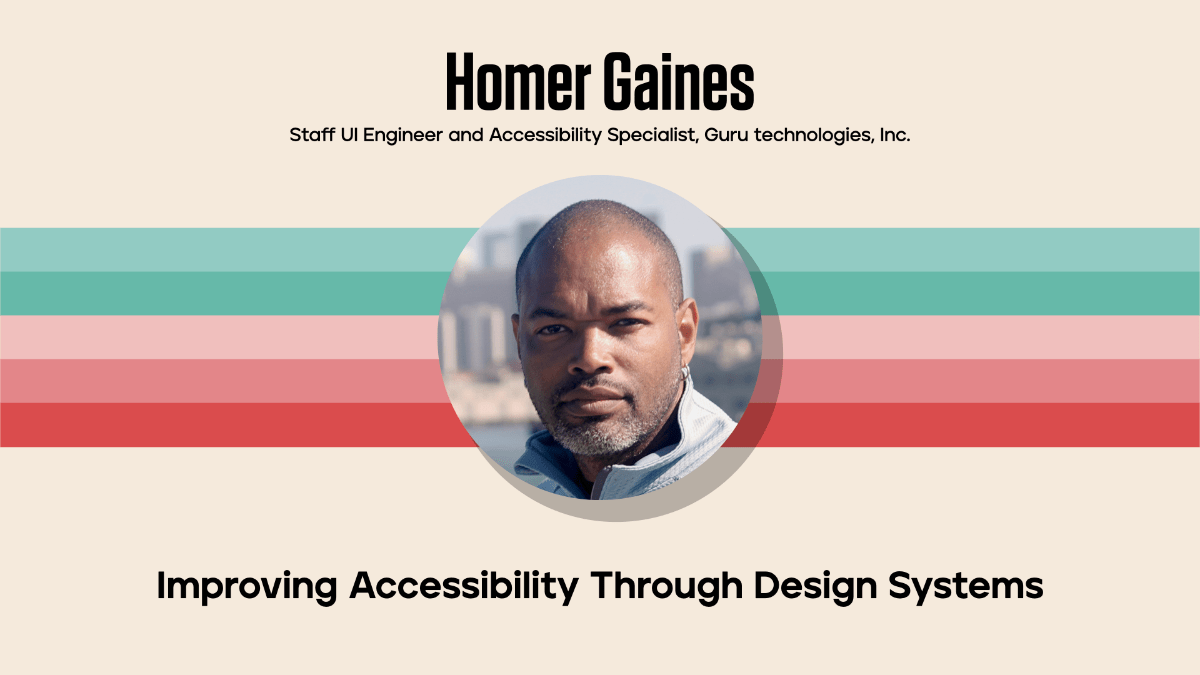Decolonizing Your Design System: Unveiling Biases and Revolutionizing Inclusion
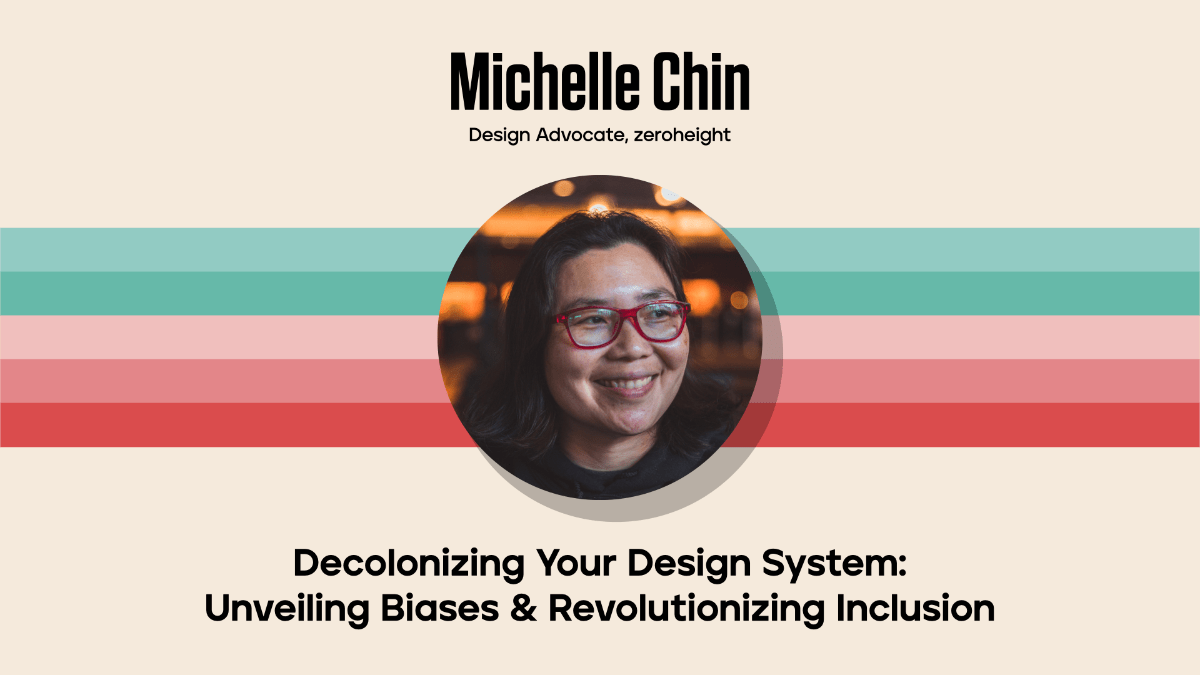
Introduction
Nathan Curtis introduces Michelle, a design advocate at Zero Height, highlighting her roles in the design community, career coaching, and her involvement in Design Systems WTF Podcast and Bepela Design Systems Meetup.
Welcome Michelle
Michelle is welcomed to the stage to begin her talk on pushing the boundaries within the design system world.
Content Warning
Michelle provides a content warning about sensitive topics including slavery, racism, genocide, and white supremacy, and offers support during breaks for anyone needing to discuss these issues.
White Supremacy in History
Michelle starts by discussing the historical aspects of white supremacy, including its role in European colonialism and the enslavement of African people.
Legislative Forms of White Supremacy
Exploring how white supremacy influenced legislation like the Chinese Exclusion Act and its impact on Chinese immigrants in the United States.
Cultural Genocide
Michelle discusses the cultural genocide of Native Americans through forced assimilation in Catholic boarding schools.
Implicit Biases and Personal Experience
Michelle shares a personal story highlighting implicit biases in her neighborhood, relating to her and her husband's racial identities.
Connecting to Design Systems
Michelle transitions the discussion to how these historical and societal issues intersect with design systems, using examples like UI elements and buttons.
Who Writes Our UI Guidelines?
Examining the lack of diversity among those who have created popular UI guidelines and frameworks, and its impact on design systems.
Diversity in Design Teams
Michelle discusses the lack of diversity in design teams based on a Zero Height report and its implications for cultural considerations in design.
Decolonizing Design Patterns
Michelle explores the concept of decolonizing design systems by focusing on patterns rather than components, emphasizing the importance of cultural context.
Long-Term Strategies for Inclusive Design
Michelle provides insights on hiring diverse teams, personal and team learning for growth, and contributing to the design system community.
Creating a Global Pattern Library
Proposal for a global pattern library that considers cultural contexts, leveraging design tokens to create inclusive design systems.
Closing Remarks and Invitation to Contribute
Michelle concludes her talk by inviting contributions to the global pattern library project and discussing the importance of taking surveys for design system documentation.
Q&A with Nathan Curtis
A Q&A session where Michelle discusses implementing cultural context in design patterns, encouraging good design choices, and sharing strategies for inclusivity in design systems.
Nathan Curtis: All right, it's my, my pleasure and privilege to introduce Michelle.
Michelle is a design advocate at Zero Height.
Michelle serves as, uh, the design community by sharing knowledge, building bridges, and identifying community needs.
Among other things, Michelle also career coaches underrepresented tech communities, co hosts Design Systems WTF Podcast, and runs Bepela Design Systems Meetup in the Bay Area.
Please help me welcome Michelle.
Alright, um, as, as Nathan said, I am a design advocate at Zero Height, and one of the things I get to do with my job is to do talks that kind of push the boundaries, um, within the design system world, design world.
So, uh, I'm excited to talk to you about this today.
Um, before I get started, I wanted to give you a little content warning.
Some topics may be triggering.
I do touch on slavery, racism, genocide, white supremacy.
Um, and please take the time and place, uh, and space that you need to take care of yourself.
I'm available to talk throughout the day.
More than happy to talk.
Find me during the breaks.
All right, um Let's jump into it.
White supremacy.
Uh, so I told you this would wake you up.
Um, so white supremacy is the belief that white people constitute a superior race and should therefore dominate society, typically to the exclusion and detriment of other racial and ethnic groups.
And this was a key justification for European colonialism.
So we think of white supremacy, a lot of us make a beeline to the thought of slavery.
And so white supremacy does take that form of enslavement of people.
Um, so around the 1500s, uh, Europeans were, quote unquote, discovering the new world and, um, wanted to colonize those, those territories.
To do that, they needed labor, and they ended up going to Africa and capturing a lot of African people.
Stealing them from their homes and transporting them from Africa all the way across to the Americas.
And that journey across the Atlantic Ocean was called the Middle Passage.
And when I learned about slavery in elementary school, I wasn't mature enough to understand, like, really what it was, except for slavery's bad.
Um, but it was really, really bad.
So, what ended up happening is that people were taken away from their tribes.
Not even taken away from just their tribes, but their family.
And they were put into these ships crammed full of people, with people they didn't know, people they couldn't communicate with.
And it was hot, they weren't, they were starving, they were sick, and they were dying.
And in addition to that, some people chose to commit suicide because that was a better option for them to then make it through this middle passage.
So, the slave traders did all this to maintain a semblance of control with enslaved people.
Now, white supremacy can also take the shape of legislation.
So, in the mid 1800s, there was a transcontinental railroad being built.
And that was a railroad to connect the east coast of the United States with the west coast.
And they needed labor to do that.
So, they had a lot of Chinese immigrants come in from the west coast and help build the railroad.
But they didn't want the Chinese immigrants to stay, so a lot of petition, politicians and other activist groups really petitioned hard to convince people that Chinese people can't stay in the U.
S.
And they ended up passing the Chinese Exclusion Act, which was the first overtly racist act passed in the United States.
Now, part of this act meant that Chinese women couldn't come to the United States, and they did that intentionally.
So, Chinese families couldn't establish roots in the United States.
If you wanted to have a family, you had to go back to China.
So, um, on paper, I am second generation Chinese American.
My dad, uh, came to China, came from China to the United States, and, um, set down roots, and I was born here.
Now, technically, I'm actually fourth generation Chinese American, but my grandfather and my great grandfather weren't allowed to settle roots even though they were in the U.
S.
So white supremacy can also take the form of cultural genocide.
And in the 1800s, to about 150 years, or for about 150 years, which kind of puts us at like the 50s and 60s, so very well within like our generation, our parents generation, our relatives generation, this went on.
Um, so there was a law that allowed Catholic boarding schools to take, uh, Native American children away from their families.
Raise them in these boarding schools and strip them of any semblance of culture that they had.
So, stripping them of their typical, uh, clothing, for, uh, European based clothing, uh, you know, forcing them to only learn English, forget their native language, um, and then forget a lot of the cultural traditions that they had and their families had, and also just stripping them away from their families in general.
So this is very traumatic, and it was a way to kind of erase They're Native American Indigenous culture in favor of European culture.
Now, you might have heard about this, um, in the couple years because there was a lot of, uh, information about, um, mass graves from these boarding schools.
And so, if you look on YouTube, you can see a lot of, um, documentaries of people being interviewed, people struggling to be interviewed who went to these boarding schools.
Um, they're very well alive today and, and they, you can tell the trauma that they went through.
In this experience.
Now, in a little bit of a lighter note, um, white supremacy fuels implicit biases.
So, um, this is a story about me and my husband.
We live in Oakland and we have a house and we were really excited to get a house in Oakland and it was covered in weeds, um, and so I was like, we need to tidy this up.
So we're out there trying to make our house look really great, or our yard look really great, and the neighbor walks by.
So they're like, oh hello, you know, small talk, you must be the new owners.
And we're like, yeah, we just moved in, nice to meet you, cordial, everything was fine, great.
So, we continue, my husband is like, I'm a software engineer.
Like, outside is not my, my wheelhouse.
Outside's not my thing.
I should be in front of a computer playing video games.
I'm like, okay, but you know what?
Like, I, I'm a little vain.
I don't want to have the house, the yard look like a little messy.
Like, I don't want to be one of those, like, conspiracy theorist houses in your neighborhood, if you know what I'm talking about.
So I'm out there pulling weeds.
And if you're not from California, uh, we are always in a drought.
And the weeds are really hard to pull out when you're in a drought.
Like, They often break off and that just means that the roots are still there and they're gonna grow again.
So pretty miserable, but I'm out there because I'm like, you know what?
We need to make our house look, our yard look really good.
So again, and this actually happened to me twice.
Another neighbor walks by and we're like, oh, hello.
Do you live here?
And I'm like, that's weird.
Like, of course I live here.
Why would I be pulling up weeds at someone else's house?
Like, pulling up weeds is like a pain in the ass.
Like, Would I just do that somewhere else?
I don't think so.
And it just, I was like, what a strange question.
And then I thought back to when the other neighbor asked if, um, my husband and I were owners.
And I'm like, that's a weird, this phrasing's really weird.
And then it dawned to me, I'm like, oh, shit, this guy thinks that I might be the gardener for this house.
And hearing that and thinking that and understanding that, even though this neighbor and the both neighbors who ended up doing this didn't have any ill intentions, but it was their biases that kind of, you know, helped them come up with a thought that was hurtful to me.
It immediately felt like I was put in my place, and the fact that it happened twice, I was like, oh, damn.
Like, as, as a woman of color, like People don't think I can own a house.
Um, so, you know, that, that is something that, even though it was super minor, still really affected me.
And, through all this, centuries of white supremacy really normalized systemic racism and implicit biases.
All right.
So you might be thinking, Michelle, this is a design system conference, here we're talking about design systems, and you're like, it's just a button, right?
And you're like, it's, it's not racist, it's a button.
And you might be thinking, okay, now that you moved to California, you're like extra woke and that's, you're being a little too much.
And then you might go, you know what?
Everyone needs buttons.
People of all cultures need to push a button to purchase things on Amazon.
Um, and, and do other tasks.
And you know what, these UI elements that we use in our day to day, they work for the most part.
We've kind of figured it out.
We all need to use select menus, check boxes, buttons, that type of thing.
So you know, you're thinking maybe it's not a big deal, but when you think about who wrote our UI guidelines, the guidelines that we use day in and day out.
For our, uh, day to day tasks, for our jobs.
We have a panel, so we have, um, Brad Frost from Atomic Design.
The Apple Human Interface Guidelines was created by a gentleman named Bruce Tognazzini.
And then the, uh, as you know, the, the ten usability heuristics that we all know and love and reference all the time was created by Jacob Nielsen.
And Material Design was co created by John Wiley.
Now if you look at this panel, you're noticing that this is very monochromatic, monogender, people who have, uh, kind of paved the way for the, the guidelines that we use every day.
But you're like, you know what, I get that, but my design team my org, my design system team, we're more diverse than that.
Okay, maybe that's the case, but in, um, earlier this year, uh, New Zero Height released a report called How We Document, based on a survey that we did a year ago.
We have a new survey out today, which I'll share the QR code.
Um, but the report we released earlier this year, and I asked some demographic questions.
And it turns out that over half of the respondents were from Western ethnicities.
Which left less than half for everyone else.
So you think about every other culture on the planet, 38%.
So what does this mean?
It just means that teams don't reflect the world.
So if you look at the world population, 17 percent is from Western.
And the rest, 83 percent is everyone else.
And this is clearly not a one to one mapping of the world.
So what's happening here is that we're missing cultural considerations from a majority of the world.
And it's not always intentional.
Kind of like the neighbor who came up to me and asked if I lived there.
It wasn't intentional.
His intention was not to cause harm, he was just making conversation.
And white supremacy is so commonplace.
So, um, you might be familiar with these M& M characters, and in 2022, um, M& M wanted to be more inclusive with their brand.
So rather than the original, um, peachy colored pink skin tone for arms and legs for their M& M characters.
Which, if you think about, it's just kind of weird.
Um, they changed into, they're wearing tights, and through the white tights, you can kind of see their candy colored coated shell, which kind of makes more sense.
So, my, um, friend and I at work were talking about this, and we're like, this is really cool.
And one of our former coworkers, which I will say former for a reason, goes, Hey, you know, this is weird, this never occurred to me, I never thought about this.
And, of course not, because as a, cis white male, he's never had to think about anything.
This just seems normal for him.
And I gave this talk in the United Kingdom, and I met a woman from Chile, and after the words, she came up to me, and she's like, Michelle, totally get why that guy didn't get it, but also, as a person of color, I never thought twice about these M& Ms either, and it's because white supremacy is so commonplace.
It's just expected that this, that the M& M characters are gonna have a finally, a white complexion.
So why does this matter?
So design system teams create the foundations that products are built from.
And if there's cultural context missing from the foundations of our everyday building blocks, it will be missing from those products.
And, if you weren't aware, designers carry a huge, huge responsibility to serve our users.
So if we're missing cultural context, we're not doing our users proper justice.
We're not reflecting them, we're not looking out for them.
And if you're not familiar with the weight that designers, and, and designers in the sense of anyone who's creating something for someone else, so it could be an engineer, could be a product manager making decisions, we have a huge responsibility.
And I highly recommend reading this book, Ruined by Design, by Mike Montero.
Um, it is, uh, it's a very real book.
It's very, it's also funny because, you know, you kind of need to cut the, the reality with with some fun, um, and I guess for true transparency, like I, I had a hard time getting through this book because I would get chills down my spine about finally understanding the gravity of the responsibility we had as designers.
All right.
So now you might be thinking, OMG, my design system might be racist.
Um, but really, Michelle, like how do you decolonize a button?
Because it's, it's a button.
So spoiler, it's not always in the components.
It's actually in the patterns.
So patterns are models for making things.
And in design systems, they can have prescriptive elements, so colors, border radiuses, line thicknesses, but also guidelines that allow for situational flexibility and decision making by the designer.
So based on your situation where you want to put an empty state, the designer might make a call on what that might look like or what the language might be used.
But more broadly speaking, this is where cultural context comes into play.
So if you ever want to see a really well designed website that is very, very culturally embracing, check out IKEA's websites.
So when you go to IKEA.
com, you can pick a country and not even that, you can pick a language within that country if there are multiple languages spoken in that country.
So these are three examples.
Um, the middle one is the one that most people have probably seen.
This is the, the US version.
Um, but you can see the left one.
In Japan, there's a lot more information and that's because Japanese people like to have a lot more context.
If you go to Japanese websites, there's gonna be like so much text and you're gonna be like, Oh my gosh, this is such bad UX.
But for them, it's great because they want to know everything before they jump in.
And the little black box that you can see in the top right, that's actually a tooltip that displays when you load.
So it's not even displaying when you hover over it or click on it.
It just displays when you load.
So that's kind of how much they love having that information.
And then in Egypt, they speak English and Arabic.
But if you look at the Arabic, they, uh, design it so there's right to left design.
And it's very well designed.
You can see all the elements that are priority are on the right side.
Um, and it takes into consideration what's important to Arabic speakers.
All right, so now you're super excited and you're probably going How do I decolonize my design system?
And rather than give you specific tactical tips and tricks, I'm going to talk about some long term things that you can think about.
So first we'll talk about hiring, talk about your own personal learning and your team's learning and growth, and then ways that you can contribute to the design system community.
So when it comes to hiring, I think a lot of times when you don't have a diverse design system team or design team, and you have people that really look like you, literally, uh, you go to design critique and you're saying, Hey, what do you think of this design?
And they're all gonna be like, I like it.
And you can think, you know, I've done a good job because I didn't just design in a silo.
I went to a design crit and asked for feedback and I got some feedback and they all liked it, so let's just ship it.
But, if you hire a diverse design team, or engineering team, or any team for that matter, and you ask for feedback, and you're like, hey, what do you think about this design?
You're gonna get a lot more varied answers.
You're gonna be like, hey, did you consider this?
Or, I like this, but I might be a little concerned about this aspect.
What about this?
And, from this, you'll get a lot more feedback, a lot more valuable feedback, and you'll also grow as a designer.
So, getting to this stage isn't really easy, and a lot of it means going out of your way.
So, going to meetups, outreach events, even working with universities to recruit and make an effort to hire a more diverse team.
It does take time.
A lot of times, I know we're all busy.
We don't feel like we have the time, but it pays off.
So, it might mean being okay with being inconvenienced to make a better team.
If you think about it, some of the hiring systems that we have in place aren't always accessible to everyone.
So you're not going to get all the right candidates that you're looking for to create that really diverse and dynamic team.
And you can't say like, well, nobody applied through my, my design, my, uh, recruiting tool.
That's, that's not good enough.
Like that's where you have to really inconvene yourself, inconvene yourself, think creatively, maybe get the rest of your team involved to find people to really make your team better.
So the second aspect is learning.
And I think travel and observing is a really, really great way to do this.
So I drew a picture of a plane because this wasn't meant to be like, let's just go down to LA and see how different the culture is there and observing is as interesting that as, as it is.
But it's really like getting somewhere on a plane far away.
See the rest of the world.
Um, and then when you're observing, not just thinking about the what people are doing, but how they're doing it, and why they're doing it.
You really use those UX skills that you have, and that curiosity.
So, this is from a recent trip to Japan that I made.
And it was just really interesting, because like, their subway system is covered in signs, covered in directions.
And what's going on here is people are waiting for their train.
But when I start to think about the how, I'm like, okay, the floor is marked, very, very obviously for each line, and people are standing in the appropriate line.
And when I start to like, unpack this and use my UX skills to kind of figure out what's going on, I'm like, You know, why are, are they doing this?
Are the train lines confusing?
Do they want to ensure no one makes a mistake?
If you make a mistake, is there really like no turning back?
You know, do they want to make sure people feel confident in where they're going?
I don't have the answers to these, but this is kind of the, the process that I encourage you to do when you are are traveling to a different place.
Now, I realize traveling is a privilege, and we can't always travel as much as we want to, but you still can learn so much without leaving your home.
And some of the things that you can do are like reading travel books and memoirs.
So I like memoirs because they have a more human aspect of a person's experience, and even though it's just like one person, you can get a good sense of what's going on.
And, and think about that how and why.
You can also watch a ton of YouTube travel videos.
They're kind of addicting.
Like, during the pandemic, I just watched a ton and I learned a lot about different places to travel.
So you can even like, what's it like to ride the train in Japan?
There's always like these helpful videos.
And it gives you a good insight to thinking about how other cultures are thinking what they're doing and how they're solving their, their design problems.
You can also meet people.
So I see this a lot at this conference, which is great, is that people are talking to each other.
They might not know each other.
And definitely talk to people that are unlike you at events and meetups.
You might learn a thing or two.
I think also usability testing with a variety of people, especially those not represented in your design team is hugely helpful.
I know sometimes we want to shortcut the practice or process and not do usability testing.
I've been there.
I've been guilty of that, but it's really important to make sure you catch any gotchas before you release the product..
And then depending on your team and size, you might have a translation team.
Talk to them about insight around like how the language varies from English, what you need to be aware of, they are super, super helpful.
And they love nerding about, out about like, cultural contexts and language.
So it's a fun conversation.
And I worked with, um, at my previous company I worked with our German translator.
And she gave me so many tips and tricks, ticks, tips and tricks about German language and UI design.
And it just made me a better designer, but also super excited about the German language.
Um, so now you're like, probably really stoked about talking to people.
I think the thing is, be patient and respectful as much as you want to know so much more about everyone's culture now and today and, and you can't get there just by asking, uh, direct questions as much as you want to.
So rather than asking like really direct questions that can be offensive, like, where are you from?
Like, like really, where are you from?
I, I'm kind of tired of that question.
Uh, ask, you know, have you always lived in London?
And maybe you'll get a lot of other like context and information that you didn't even consider when you might have just assumed like, where are you really from?
So, um, I think the big thing is avoid stating assumptions in your questions.
A lot of times we might want to seem like we know what's going on, so we might state a thing.
So like, I've heard Americans love big trucks, is that right?
And that can be kind of offensive, right?
So, um, focus on, on questions.
So maybe instead of that you can say, Hey, you know, what's transportation like?
In the Us compared to here?
Or what's transportation like compared, uh, from San Francisco to, like, L.
A.?
What's that like?
And then, lastly, the other thing that I would love for you to consider is contributing to creating patterns to your design system.
So, maybe you have a pattern that favors minimalism, or a pattern that favors more context, depending on your users.
So, you might be thinking, Okay, Michelle, you know what, we're barely able to get our components figured out, so, like, now you're asking us to do patterns?
Like, there's no way.
I need to, like, get my UI kit ready and legit.
So you might also think patterns are confusing because there's like rules that we can define but there's flexibility that we have to incorporate and that just like hurts my brain and just means more work.
I get that too.
Um, and then you might think, You know what?
Our focus is only on the Us.
market.
We don't, we don't need to think about other countries and other cultures just yet, which I kind of get that, but at the same time the Us.
has a lot of cultures in it, so also important to consider.
The one thing that all three of these have in common is is that they're excuses.
They're excuses for not doing the right thing.
They're excuses for excluding people.
They're excuses for pushing it off to someone else and making it someone else's problem.
So, anytime you feel like you're making a reason, a justification for not doing something that's gonna be a little extra work, just remember, it's probably an excuse.
Now, I never said that this would be easy, but it's definitely worth it.
You can create some really meaningful experiences for so many people across the globe.
And the more they use your product, the more engagement, the more value you've put out into the world.
So, also think about that we're undoing centuries of white supremacy.
This isn't something that we can just Command Z and make better.
There is a lot of history, you know, even from like the 1500s all the way to now.
It's centuries, and it's gonna take some time, but I think the big thing is that we don't have to do this alone.
So, in, earlier this May, um, my company hosted a design system conference called, uh, Converge, and Brad Frost, uh, did a keynote, a talk about, is atomic design dead?
And you can watch the video online, it's a really good talk.
Um, And in the talk, he talks about creating a global design system.
And I know a couple people mentioned this too, like a, like an open UI type thing, or people are just tired of designing, like, buttons 50 times over.
Totally get that.
So the idea behind this is that we all have one common component library, and we can use the technology like tokens to like re theme to whatever our needs are, and that just makes life easier for everyone.
So, in that similar vein, what if we had a global pattern library?
So, this would be a UI pattern library that considers cultural contexts that we can reference.
And, it could have cultural sketches to help us understand and get that context I'm not saying personas but like cultural sketches of like kind of what's important to know as a UX designer about different cultures, different sections of a country, that type of thing.
And it's also kind of a fun way to Uh, leverage Design Tokens.
Like, what can we really do with design tokens to help us get to these cultural patterns?
So, um, I'm actually trying to start a project in kind of creating this, like, open source global pattern library that includes cultural sketches.
And I would love for you to come join me in making this happen.
Um, I haven't started yet, but I'm about to.
So, um, really excited to do this.
I've talked to a lot of people, like, a lot of anthropologists have come up to me, which is kind of exciting.
Uh, that, that we're gonna try to figure out how to create cultural sketches, start some good conversations, maybe document a couple patterns, and eventually get to, like, a really good library that people can share.
So, I do have a call for contributions.
I wanted to make a note for my underrepresented people.
Only contribute, only contribute if you'd like to.
Don't feel obligated to undo white supremacy.
This is not a burden that you need to undertake.
I know sometimes as designers, especially me, like I'm like, I must step up and, and right this wrong, but this wasn't something that I had done.
This is kind of, and it's taxing.
There's a lot behind it, a lot of trauma, generational trauma, cultural trauma.
So only if you're in a good spot, feel free to contribute.
So for my represented people out there.
I think, you know, a lot of people are like, Hey, I, I'm an ally.
I want to help.
Use this as your motivation to learn.
Maybe you're like, okay, now this is a great like reason for me to learn more about East Asian cultures or African languages and, and just how other people are using devices, like what devices are using, and this is a great way to show active allyship.
A lot of times I think people struggle with like, how can I be a good ally?
This is a great way.
Help contribute to making this something that everyone can use.
And unburden us by carrying the weight.
So, a lot of times people who are underrepresented and marginalized have this burden of knowing that they're kind of the only one of their, their kind in the, in wherever their environment is.
It's a struggle.
And we would love it, and no one's gonna fault you for like, messing up or anything.
We would love it if you're like, hey Let me chip in.
Maybe I can, like, ask you a couple questions and write up a summary and, like, contribute to this pattern library.
That would be really, really awesome.
So, um, that wraps up my talk.
I want to thank you so much for being here and listening to my talk.
You can keep in touch with me.
Uh, through LinkedIn, um, I have a QR code that has a lot of resources that I did mention.
And, um, also, uh, I'm running the How We Document survey, uh, this year again.
If you want to take some time, probably takes like 30 minutes or so.
You're more than welcome to take the survey.
The survey kind of helps us, um, as a community understand where design systems and documentation are.
Uh, I personally am responsible for the survey, um, which means that I'm really looking out to see like how we can take some of these findings and insights and help people understand like what the job market is like if you're looking for a job, where should you be targeting your search?
What does the career path look like for a design system maker as well as like a rubric and understanding for like baselining where your team's at where your goals are as well as using this report as a like a steadfast way to provide some data to your stakeholders to advocate for design systems.
So, I would really appreciate it if, uh, you could take the survey.
Um, but also feel free to come ask me questions.
I'll be around.
And thank you so much.
Carefully get on this.
Thanks, Michelle.
Uh, so let's dive into patterns.
Um, I've always talked about UI components as feeling far more prescriptive and closed in the way that you're expected to use them and contrast that with patterns being more principled guidance, placing far more of a compositional responsibility on the people that use and apply those patterns to make good choices.
And as a design system practitioner trust that they're going to make good choices.
And so, when you talk about leading to good choices that infuse a cultural context, how do you write patterns or, uh, expose that, those principles through patterns in a way that leads to that?
And it leads to, uh, essentially good choices on the part of the people that use them.
Yeah, I think that's a great question because there is a lot of flexibility with, with patterns and there's going to be lots of different situations too.
So I think part of it is documenting, so writing really brief descriptions of, you know, what you're kind of aiming for or what the gist is, but also showing examples so people can see, like maybe they're not going to follow this one pattern of an empty state for an East Asian language to a T, but they can get a sense of what they need to do.
So I think a lot of times understand, like reading words can be hard to kind of under, like interpret as like what that should look like, but showing examples is a great way.
So like having a pattern library, you know, like, like the olden days where there was like pattern libraries of lots of different screenshots to kind of show like where, where you can take things.
In design systems, uh, we often feel detached from the people that use our products, use our assets and choices and so on as they make their products.
What have you seen, uh, in your work or in the people that you collaborate with that, uh, help them see in the products that the things they're writing in those patterns and the guidance they're creating is leading to good decisions, like, you're not going to go out and audit every single product that's ever used your design system.
How's a way to maintain visibility and make sure that you're having the impact?
Yeah, I think that it's, it's broader than just thinking about components, but really getting to know all sorts of people.
So, I think what's nice is that, like, you know, when I go to conferences and I meet people from different cultures, and we start talking about things and we're like, Oh, is this like an American thing?
Or is this a European thing?
You start to like, kind of build this library of understanding cultural context that I think can help you see if you're making those decisions well.
We communicate, and we talk with people, um, and when I talk about communication paths from a point in the organization that the design system sits in, I think about the different lateral paths.
And one path is to the developer community, another path is to the designer community.
I like to talk about feeling like you have a path to teams as a construct.
But then there's also a path upward to the people that are managing the system or even the leaderships that are accountable for the system.
If you're thinking about making change, do you, uh, to really infuse this cultural context, what paths do you follow first?
What paths do you really need to drive that change into?
And you don't have to use my model.
How do you think about, where do you direct your effort and your energy?
Yeah, I think a lot of times, especially with design systems, like a lot of it starts to be very grassroots.
I'm not saying that's the way it has to be for everything and, and for a while, like at some point you're going to have to involve, to get more, uh, funding and resources, you're going to have to involve stakeholders, so I think starting from like the ground up a little bit, I think the biggest thing is that you will probably find resistance from the top who maybe they have some OKRs where they need to like, you know, they're thinking about money and numbers and they're not thinking necessarily about people.
Um, so you'll run into some resistance, but I think that's, that shouldn't stop you.
Um, I think as designers and engineers, we need to be empowered to know that we are the subject matter experts of our profession and that we need to be thinking about things more inclusively, and if that ruffles the feathers of your stakeholders, like, still press on.
Um, I, I think a thing is like, you know, you might not think you might be able to change things, but you can.
I think one of my friends, so Brief story, uh, they, he was at a company and they had a secret Santa thing going on and you bought some, a gift online, but the form you filled out, it made you select the recipient's gender and it was just like male and female.
And he was like, this is kind of weird, like, I don't know why you have to select the gender, um, and why it was only binary.
So he wrote the company and was like, hey, wanted to know what's going on with this.
And they were like, oh yeah, we asked the gender because that way we can address the email message as like, you know, he, she, that type of thing.
And so he explained to them, you know, Like, they, they, there, there are more than one gender and I have a teammate who this is going to make feel really uncomfortable because they're transitioning and they don't identify as either one of those genders and so that company kind of took that feedback and the next year for that Christmas holiday season they removed that gender question completely.
So when you think you might not have that power, like, it can't hurt to ask, it can't hurt to try because you can actually make a difference.
I think another place where that applies is hiring.
And you talked about hiring a bit.
As a consultant, I come from the outside.
I, I, I try to help the, the conditions I see on the inside, but I really feel almost powerless.
I can choose where I choose to work, and I, I'm really proud that a lot of my management that hires me and that I essentially report to end up being women or, or, uh, other demographics and so on.
But, even for people inside design systems, uh, or inter on internal teams, they might feel powerless, or they might feel like they're not the people making decisions on hiring.
And so you talked about infusing cultural context into the, the foundations of a design system, and have you seen instances where that gets used for criteria for hiring, or that gets used to influence the kind of people that are hired?
How, how have you seen sort of a, a line from design systems and what, what you've made there, to the choices of the people you bring in?
Yeah, I think that can be really tricky to navigate because, you know, when hiring, you want to diversify your team, but you don't want to judge someone for who they are.
You want to judge them for the quality of talent that they bring.
Um, I know some places might do, uh, emphasis on hiring and screening where they might screen for women or people that identify as women to get more candidates in the pool or people of color to get candidates in the pool and kind of rotate that into that and make, make sure they're being really intentionable, intentional about bringing in more than just, uh, someone who kind of already looks like part of, of the fabric of their team.
I really liked you invoking traveling to Japan, uh, as a way to expose yourself to cultures that are, that behave differently than you do.
And the example that I've, uh, that resonated with me most was how people act on the subway, and that it's ultra quiet.
And so if you're a tourist there, you don't talk.
Everyone's very hushed and I, um, there was a white family and they were saying we had to create incentives and penalties for our kids to not act out.
So that they would become very clear that you need to behave in a different way in a different cultural context.
That's pretty extreme when you're talking about like design systems, I would assume.
But are there is an example or two that you can recount where you have helped other people, not necessarily children, but teammates, recognize the differences in behaviors and and what kind of tactics do you use to help evolve and change their behavior and help them adapt?
Yeah, I, I think a lot of times, like, I, you know, I feel like I'm in a place in my racial identity and journey to be able to talk about things.
So I'll talk about my, um, parents and their immigrant experience and my friends' like, parents immigrant experiences to provide more context around things.
It can be still hard to, like, resonate, and that's part of one of the reasons why I do talks like this, is because my, my partner is white and has never had to kind of meet these friction points in his life.
And I know he cares deeply about me, but there's some times where he just doesn't get what I'm trying to say because he's never had those lived experiences.
So I think that's kind of one of those things that, like, I try to bring examples.
I try to do talks like this to kind of shed light on situations.
I think the other thing is, like, you know, finding people.
So a while ago, I was a quality assurance tester with accessibility, and I was trying to teach people how to do more accessible stuff in their work, like tag their PDFs.
And, um, they weren't quite grasping it, but we had someone on our team who was actually legally blind.
And so I had her kind of show everyone, like, what it was like to use a screen reader, like, try to get through those PDFs.
And right away, like, they all loved her.
So they felt so horrible.
And then from there on, they were like, oh my gosh, we have to tag this PDF so Jessica can read it.
Like, it was really cool, and I wish it didn't take that moment to have to share, but I think sometimes that empathy and that experience firsthand is really needed.
So I try to find, like, ways to do that as well.
That's great.
Thank you so much for sharing that with us today.
Everyone, please help me give a warm thank you to Michelle.




